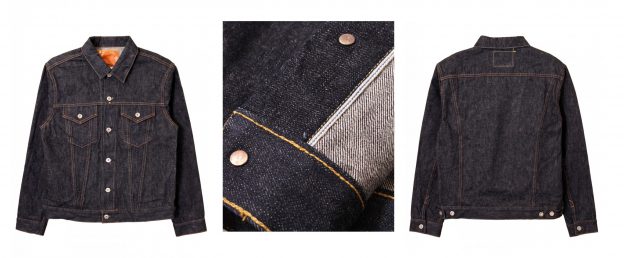For many denimheads, a denim jacket is a staple and familiar piece of clothing as the jeans themselves.
From a practical point of view, we always need somewhere to stuff our trinkets or to protect ourselves from the cold and wind. The denim jacket is the perfect answer to this issue.
From an aesthetic point of view, denim jackets will eventually receive the same fade as your favorite pair of jeans. After wearing a hard indigo jacket, whose sleeves are initially stiff from starch, you will eventually notice that it becomes your favorite everyday thing, acquiring beautiful fading on your sleeves, and things that are carried in your pockets gradually leave characteristics imprints such as “fingerprints” on them.
Another fact that makes denim jackets very attractive in their own way is its history. Appearing at the beginning of the 20th century as practical clothes for heavy work, denim jackets constantly changed while acquiring new details. All these nuances are certainly very interesting- a detail that would be reproduced for decades to come by many Japanese manufacturers.
Let’s take a look at the main types of denim jackets and their characteristic details.
Type I

This is the earliest version of denim jackets, which appeared in 1905 first introduced by Levi’s company, out of light enough denim with a density of 9OZ. Somewhat later (already in the 30s), for these jackets, a denser 12OZ denim was used, while a red tab appeared on the pocket and the jacket itself was called 506XX. The jacket had a spacious style, not constraining movements. Since this jacket was intended for work, no one was asking about the ideal landing and the right size. Next to the bar with buttons, there were special, adhered vertical folds. If the jacket was fitted too tight, they could easily be ripped open to give yourself more freedom of movement.
The only pocket was fastened to the valve with a button.
Behind the jacket was a cinch-back, which was also intended to give more freedom to the size of the denim jacket.

It is also worth noting that these jackets were short. They were thought of as working clothes, worn with jeans, which have a high ball landing. These jackets typically sat above the back pockets of jeans, so as to become more dynamic and easy for the wearer.
Let’s see some examples of such jackets available (on sale!).

A small company TCB Jeans, do a classic Japanese repro, trying to reproduce things as close as possible to the original. Here before us, is the same jacket 506XX, painstakingly reproduced by TCB.
We see a traditional spacious cut with stitched vertical folds and a cinchback behind. As well as it is necessary to a jacket Type I, there is only one breast pocket. Used American denim with a density of 12.5OZ from Memphis.
FULL COUNT
2107 FLAP POCKET 1ST MODEL DENIM JACKET

2107 FLAP POCKET 1ST MODEL DENIM JACKET
The company Full Count is also presenting its vision of the American classics of the 30s. The jacket is made quite close to history, has a spacious “working” silhouette and all the necessary details of Type I. However, denim here is somewhat denser, being of 13.7OZ, woven from long-fiber Zimbabwean cotton. This jacket will initially be very soft and comfortable.
MOMOTARO JEANS
1105SP 15.7OZ 1ST TYPE CINCH BACK JACKET

There is a version of this jacket from Momotaro. The jacket has all the traditional details typical of the 506XX, but the denim is more dense than the original. Its density is 15.7OZ. Also, the jacket has all the recognizable elements of the GTB series- it’s tab on the pocket with the peach symbol and the “combat stripes” of the Momotaro flag on the sleeve.
BURGUS PLUS
71928-XX LOT.71928 NATURAL INDIGO SELVEDGE 1ST TYPE DENIM JACKET ( ONE WASHED)

71928-XX LOT.71928 NATURAL INDIGO SELVEDGE 1ST TYPE DENIM JACKET (ONE WASHED)
Great option Type I from Burgus Plus. The main feature of this jacket is that its threads are colored with natural vegetative indigo by the extract of an indigo plant.
Type II
This type of denim jackets were also created by Levi’s in 1953. In the 50’s, gin clothing gradually gained increasing popularity and such jackets were used quite actively already-not only as work outfits, but also as everyday clothes. This model was called 507XX.
The design has already undergone some changes during this time. Stitched folds from the front are still preserved. (Now there are two pockets.) The large front pockets were large enough and they were very conveniently located, exactly in the middle of the jacket. Cinch-back from the rear were abandoned, and the sleeves in the cuff area were reinforced with copper rivets. Type II is probably the most popular source of inspiration for Japanese manufacturers. In this jacket there is everything: characteristic aesthetics, convenience, and style.
Let’s see the jackets in this style, from Denimio.

TCB 50’S JEAN JACKET
Again, for those who are primarily interested in historical reliability and proximity to historical samples, Type II from TCB will be of your greatest interest. Here are all the necessary elements: large patch pockets, detached folds near the buckle and even a red tab on the breast pocket imitates the old Levi’s. For the production of this jacket, old sewing equipment is used, as in the distant 50’s. Denim has a density of 13.5OZ, it is Zimbabwean long-fiber cotton.
MOMOTARO JEANS
MJ2103 14.7OZ DOUBLE POCKET JACKET

A very interesting version of this jacket is from Momotaro Jeans. The cut of this model of the jacket has a more modern look, designed for a more dense landing, in contrast to the classical model Type II. This jacket is released in the Cooper Label series with the same Zimbabwean cotton and density 14.5 OZ. The pockets of the jacket are sewn with a beautiful indigo lining, while bronze buttons on the front have a peach image.
ONI DENIM
02517GCKHN 16OZ GREEN CAST KIHANNEN 2ND TYPE DENIM JACKET

02517GCKHN 16OZ GREEN CAST KIHANNEN 2ND TYPE DENIM JACKET
Type II from Oni denim is made of 16OZ Kihannen denim. This type of denim is characterized by a beautiful greenish shade and very beautiful contrasting fading, emphasizing the texture of denim. The very texture of this denim is made by vertical “stripes”, which in due course will be very beautifully allocated. All the buttons of this jacket are made black, like the jeans of the kihannen series.
Type III

The latest generation of these jackets, which was originally intended for truck drivers, was the so-called trucker jacket. This jacket was first launched in production in the year of 1962. Kroy had a more dense landing, emphasizing the line of shoulders. Stroke vertical folds near the clasp are a thing of the past. The pockets are much smaller in style, their design changed. (instead of the waybills, slotted pockets were now used) Two long vertical lines now pass through the pockets for the strength of the structure. On the back, as well, there were no any folds and two seams were also stitched vertically. It is very beautiful and memorable – the style that almost immediately made this jacket popular right up to our days. It is worth noting that the Type III pockets in its classical form did not have this detail until a relatively recent period.
In one way or another, many manufacturers try to reproduce this jacket in their collections. Without it, history would be incomplete.

TCB 60’S TRUCKER JACKET
In general, and considering jackets based on Type III, you can see that TCB tries to stick to history as closely as possible. Denim has a slightly lighter shade, which is very typical for the denim of the 60s. The jacket has small breast pockets with red tab, bronze buttons and a patch of pressed paper. That is, all the details here are made as carefully as possible.
BURGUS PLUS
71955-XX 14.5OZ NATURAL INDIAN INDIGO DENIM JACKET

71955-XX 14.5OZ NATURAL INDIAN INDIGO DENIM JACKET
Type III from Burgus Plus. Here the manufacturer again has its own vision of the subject and on the basis of the classical. Buttons here are used in the form of donuts button, which, since in the times of Type III, have already gone down in history. However, the manufacturer prefers to use them to impart a certain color to his jacket. The density of denim is 14.5OZ. And again we see threads colored with natural indigo.
FOB FACTORY
F2309 SELVEDGE STRETCH DENIM 3RD TYPE JACKET (WASH)

F2309 SELVEDGE STRETCH DENIM 3RD TYPE JACKET (WASH)
A laconic and simple jacket Type III from FOB Factory. The jacket is made from smooth denim of medium density, similar to what it was in the 60’s. There are small slotted pockets on the chest and all the other details that are characteristic for this type of jacket.
Just for a small conclusion, history and classical tradition are not always a rule or tradition that retailers/ manufacturers have to copy, but rather act as a source of inspiration for various Japanese companies that are trying not only to copy old vintage things, but to express their vision, turning the whole denim industry into something that possesses insight and changes.
We absolutely promise to have all the nooks and needs a denim fan desires to keep them happy. If you have any questions, we will always try to help you with your choice.
Enjoy shopping!


